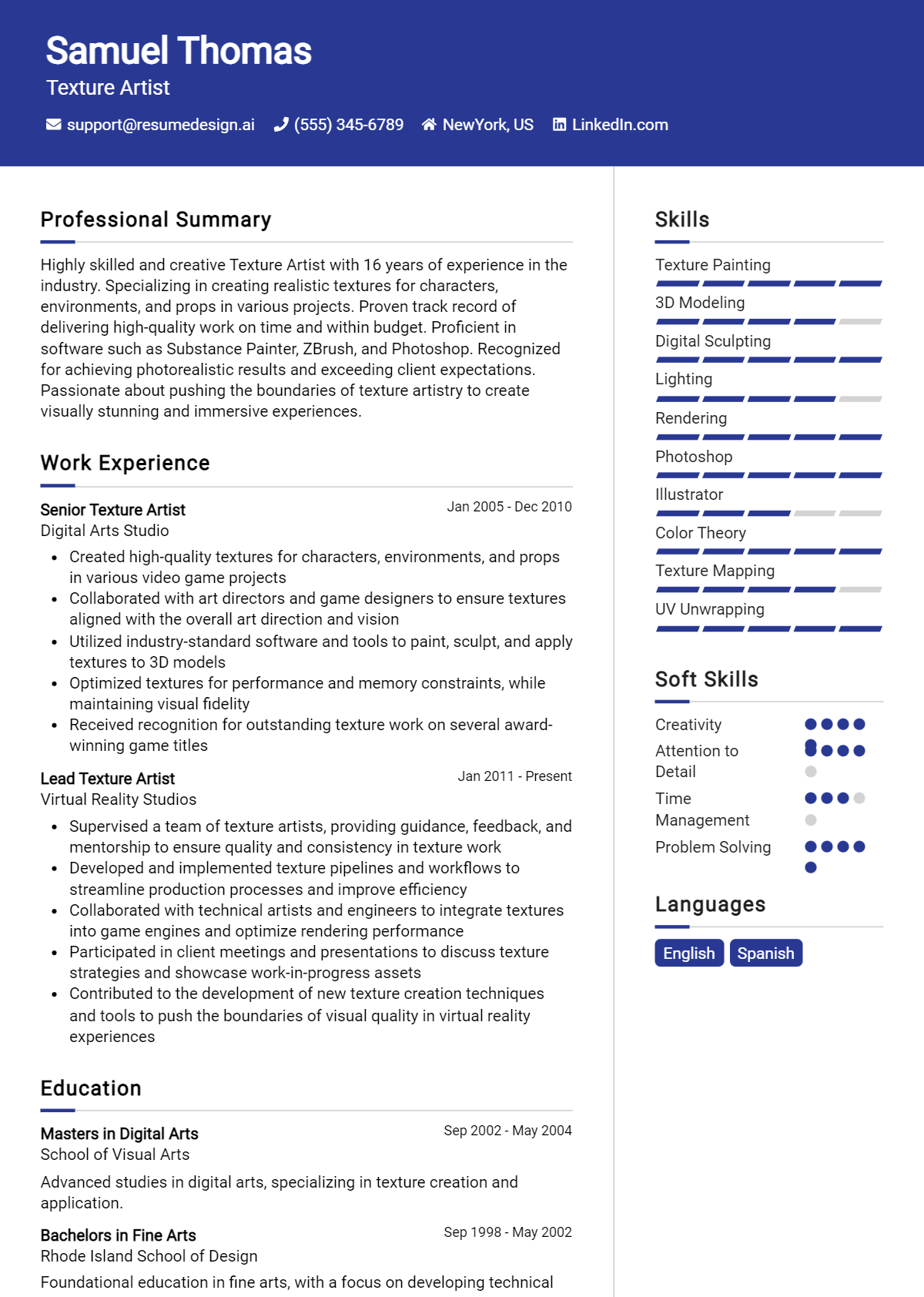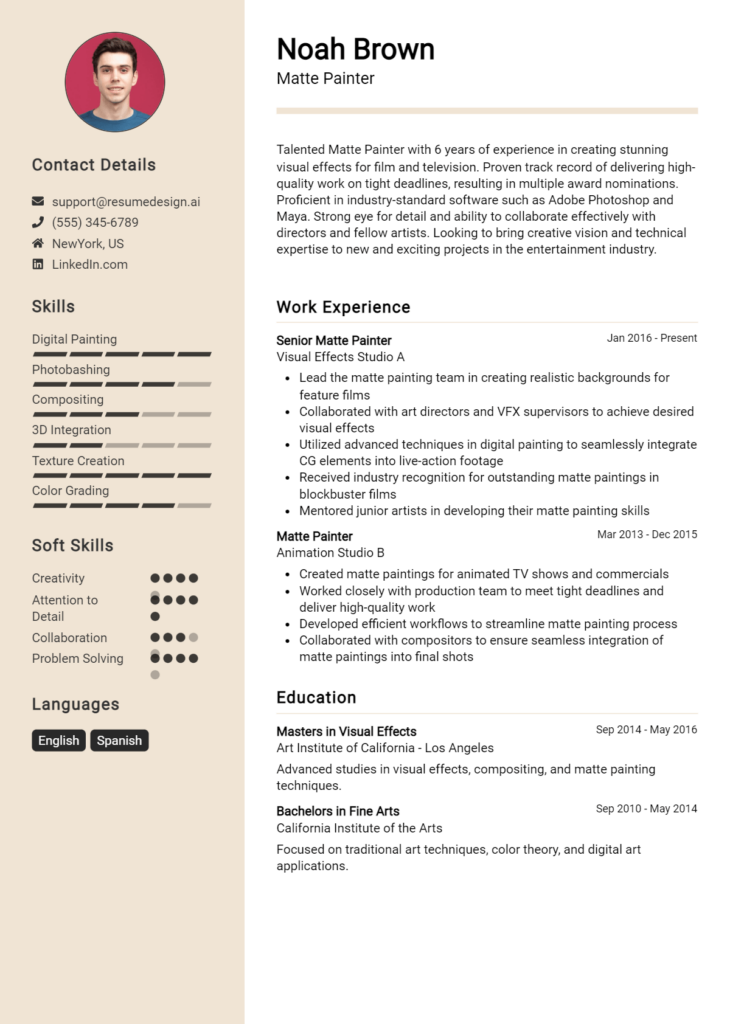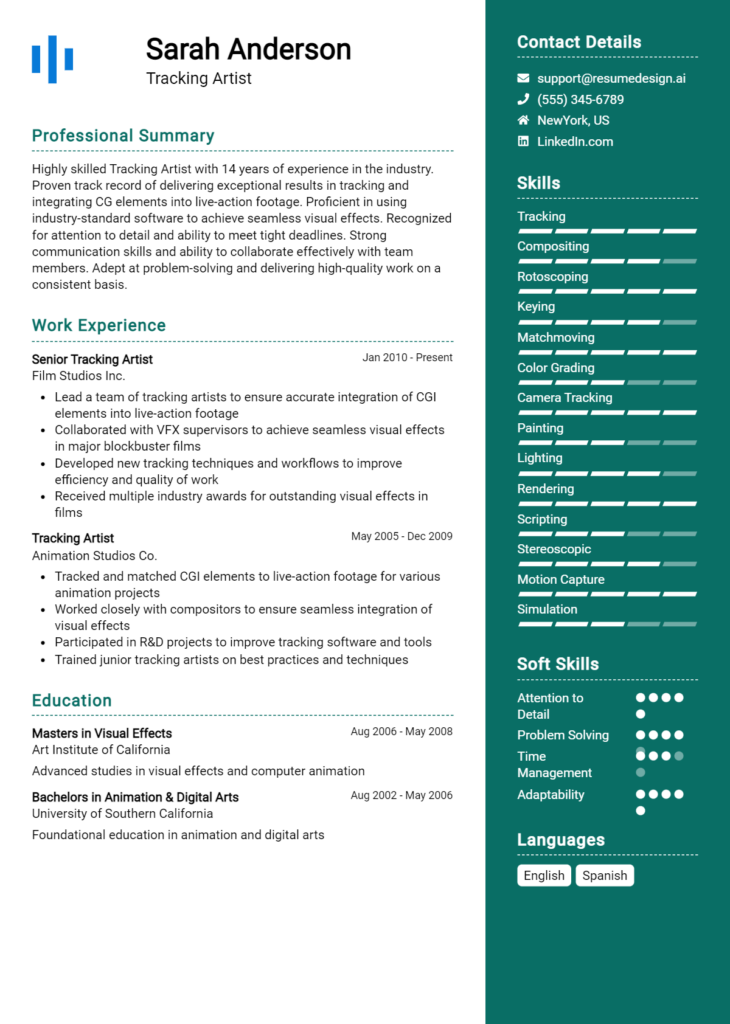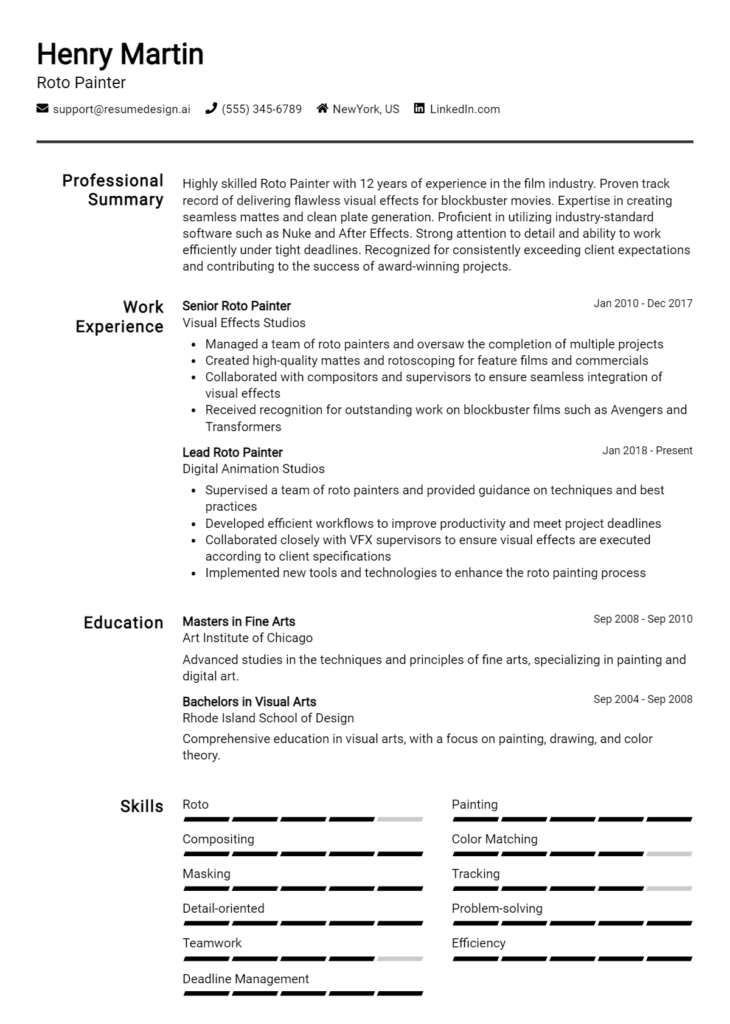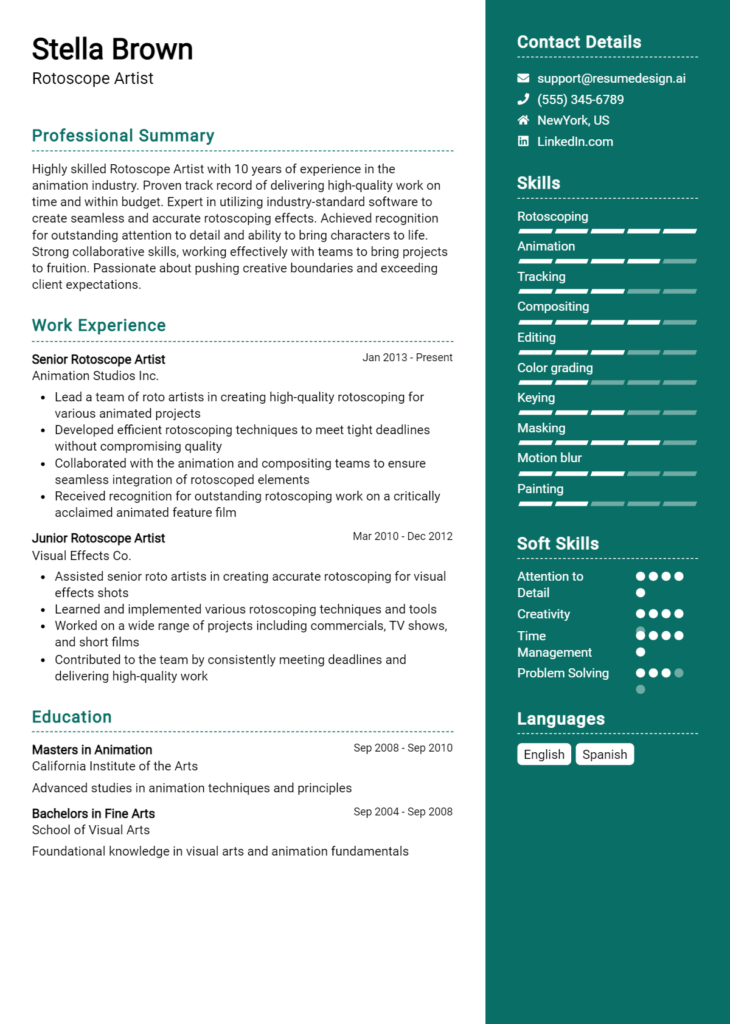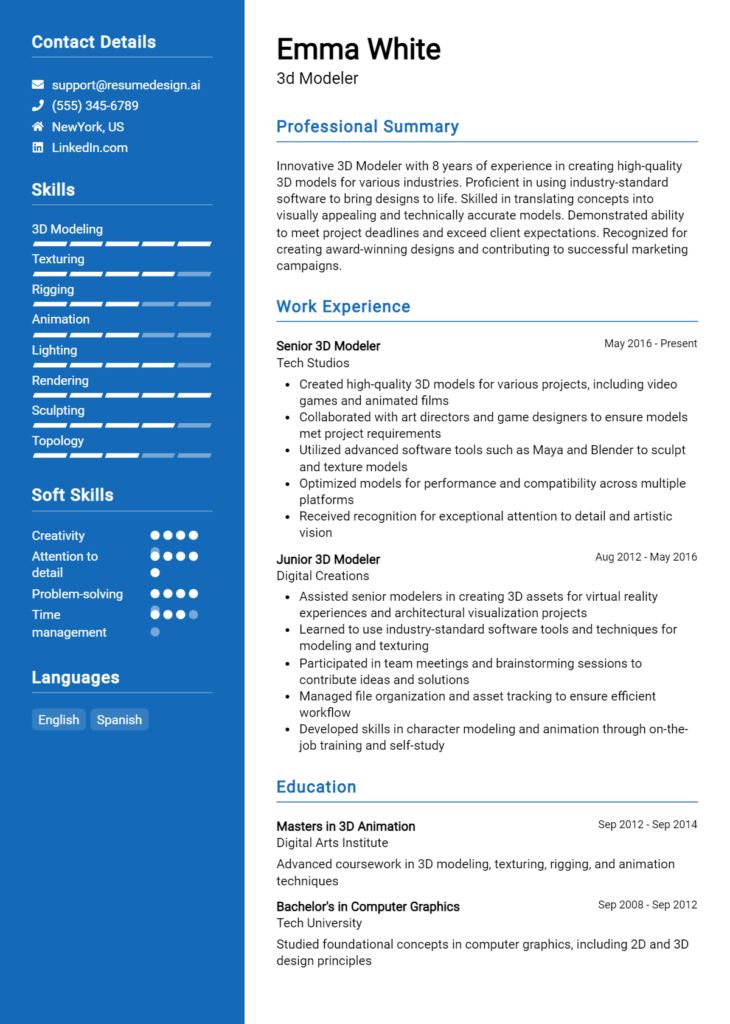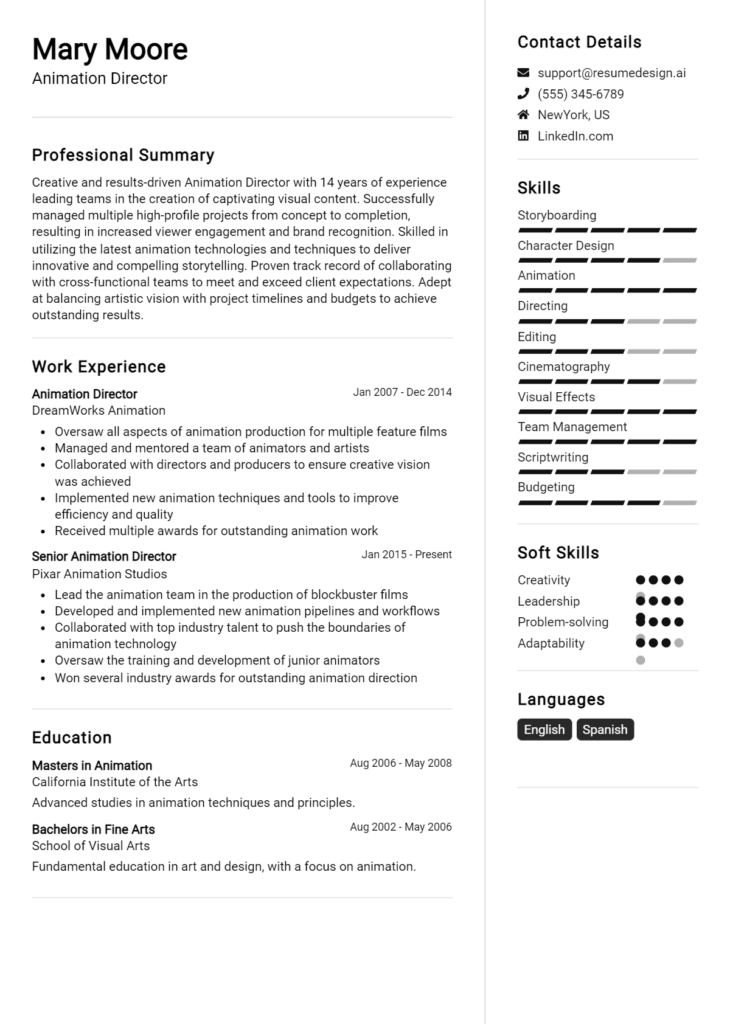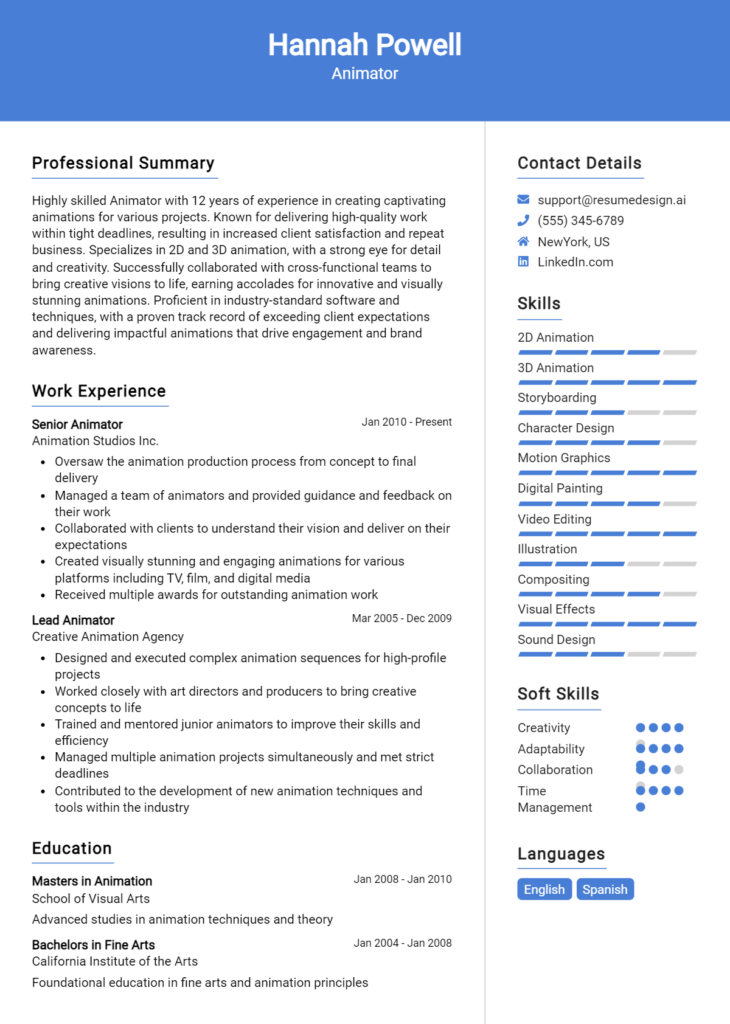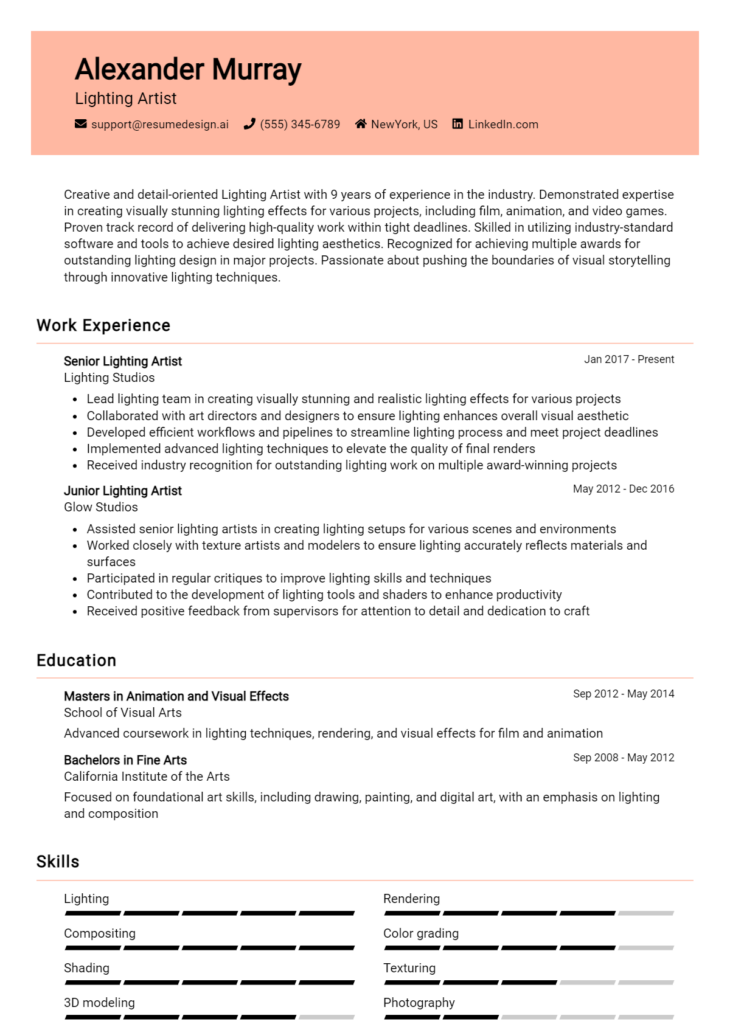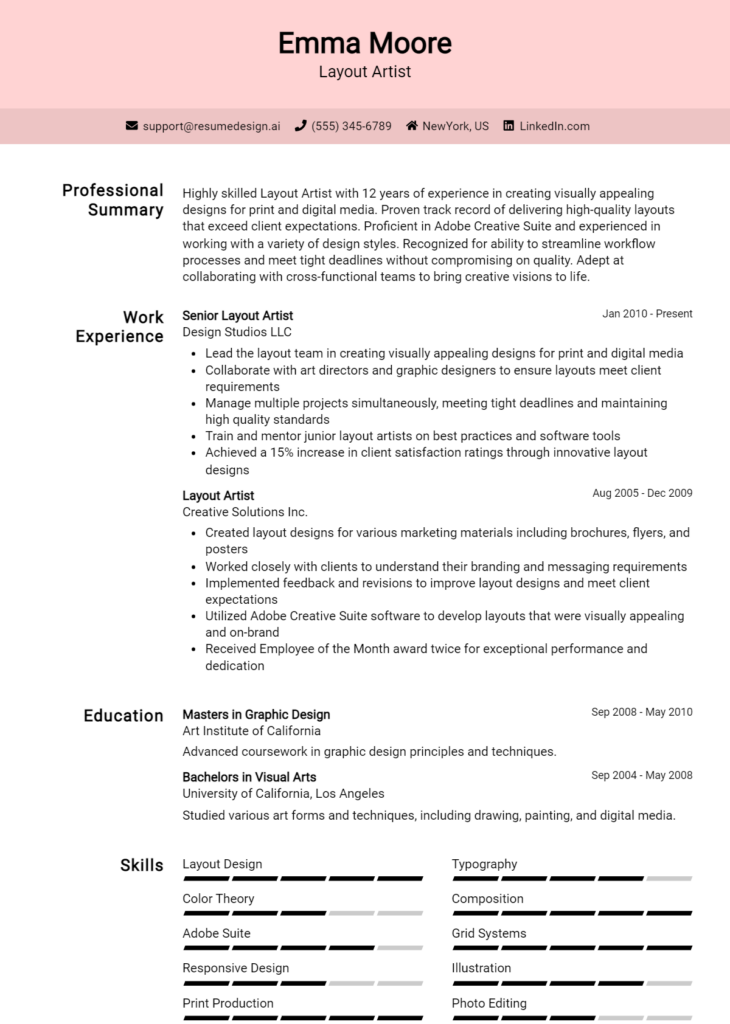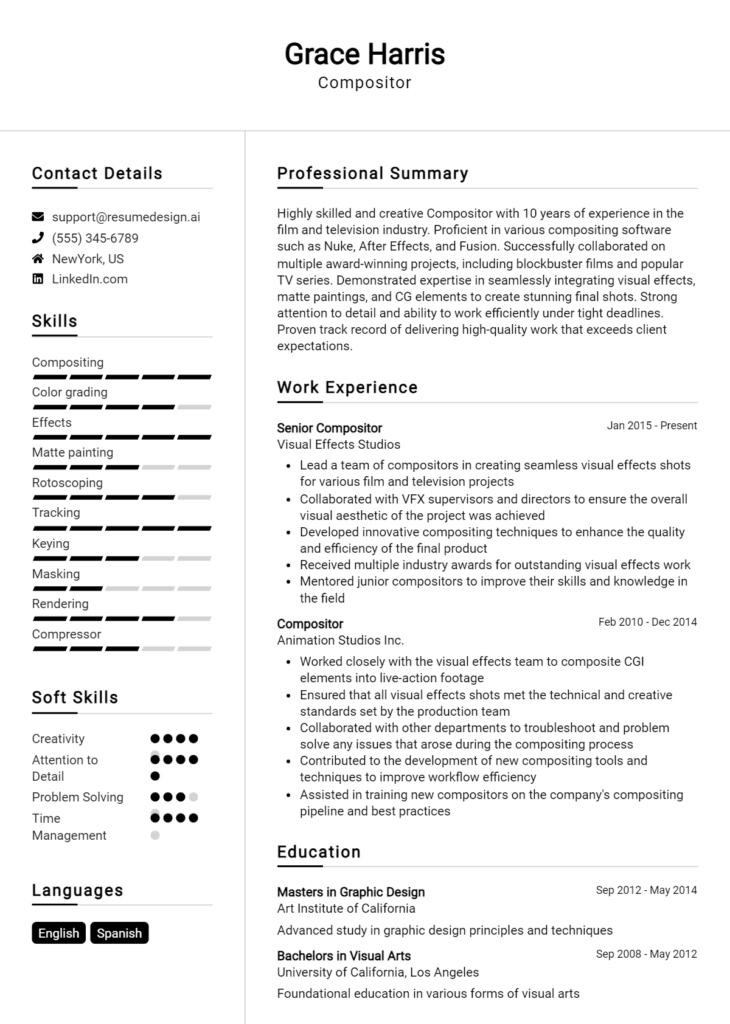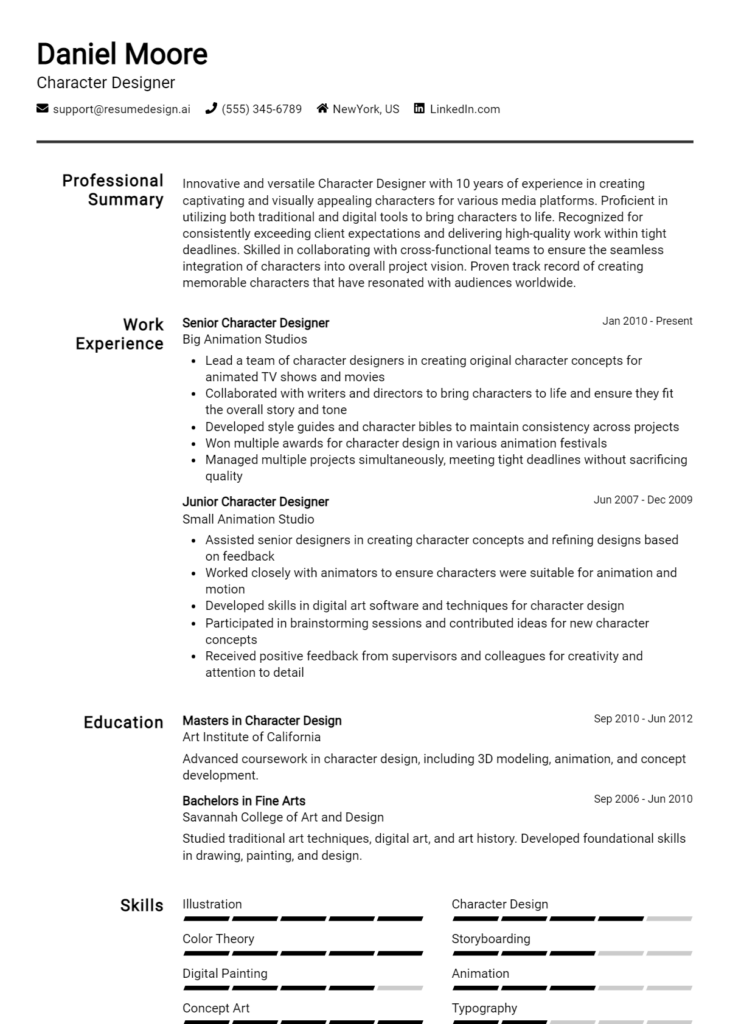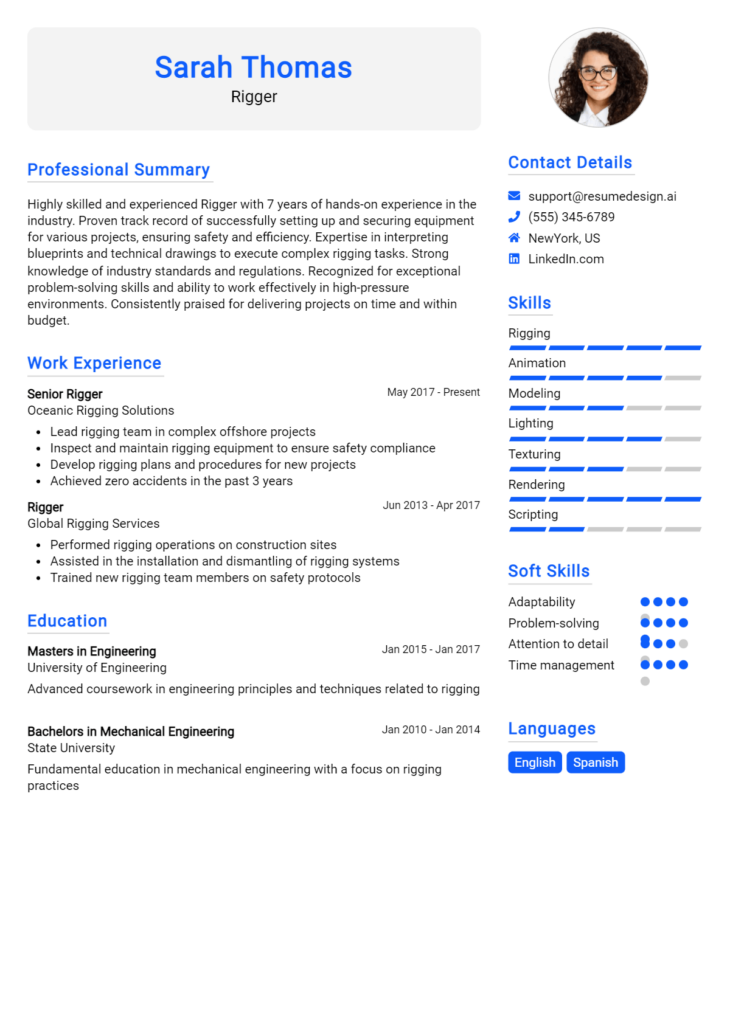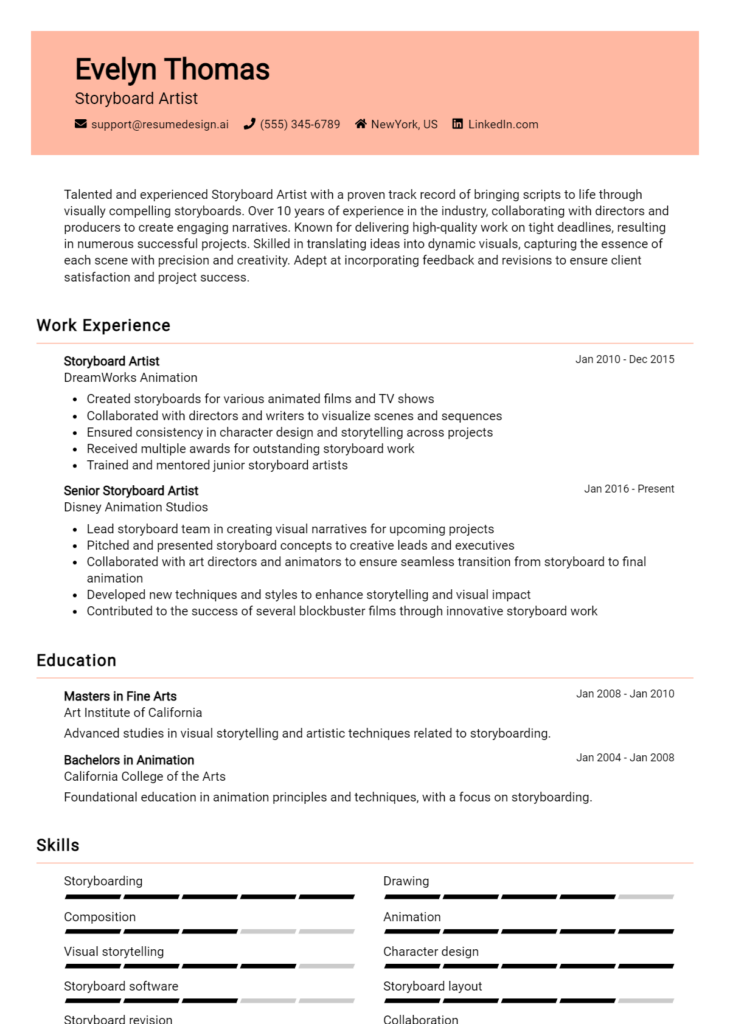z57zE2febWFNWzGHmYZf
Texture Artist Core Responsibilities
A Texture Artist plays a crucial role in the visual development of a project by creating detailed surface textures for 3D models, ensuring they are both realistic and engaging. This position requires a blend of technical skills, such as proficiency in software like Substance Painter and Photoshop, alongside strong operational capabilities for collaborating with other departments, including modeling and lighting. Problem-solving abilities are essential for overcoming challenges in texture application, directly contributing to the organization's artistic vision. A well-structured resume that highlights these qualifications can significantly enhance a candidate's appeal to potential employers.
Common Responsibilities Listed on Texture Artist Resume
- Create high-quality textures for 3D models across various platforms.
- Collaborate closely with 3D modelers and animators to ensure texture fidelity.
- Utilize various software and tools to produce and edit textures.
- Conduct research and reference gathering for realistic texture creation.
- Optimize textures for performance and memory requirements.
- Implement feedback from art directors and team leads to refine textures.
- Maintain a consistent visual style in line with project guidelines.
- Troubleshoot and solve texture-related issues during production.
- Document and organize texture assets for easy access and management.
- Stay updated with industry trends and techniques in texture creation.
- Participate in team meetings to discuss texture strategies and progress.
High-Level Resume Tips for Texture Artist Professionals
In the competitive world of visual arts, a well-crafted resume serves as a crucial tool for Texture Artist professionals looking to make a lasting impression on potential employers. Often the first glimpse hiring managers have of a candidate, the resume must effectively showcase not just technical skills, but also unique achievements that set one apart from the crowd. A thoughtfully designed resume reflects a candidate’s artistry and professionalism, making it essential to highlight relevant experience and the specific skills that are most valued in the industry. This guide will provide practical and actionable resume tips tailored specifically for Texture Artist professionals, ensuring that your first impression is both compelling and memorable.
Top Resume Tips for Texture Artist Professionals
- Tailor your resume to the job description by incorporating keywords and specific skills that match the requirements of the position.
- Include a strong summary statement at the top of your resume that highlights your key skills and career goals as a Texture Artist.
- Showcase relevant experience by listing projects that demonstrate your expertise in texture creation, including any notable clients or collaborations.
- Quantify your achievements where possible, such as the number of projects completed, deadlines met, or improvements made to workflow efficiency.
- Highlight industry-specific skills, such as proficiency in software like Adobe Substance Painter, Mari, or Blender, to demonstrate your technical capabilities.
- Include a portfolio link that showcases your best texture work, ensuring it is accessible and visually appealing.
- Use bullet points for clarity and conciseness, making it easy for hiring managers to quickly scan through your qualifications.
- Keep the design of your resume clean and professional, using appropriate fonts and layouts that reflect your artistic style without being overly flamboyant.
- Be mindful of the length of your resume; aim for one page unless you have extensive experience that warrants a longer format.
By implementing these tips, Texture Artist professionals can significantly enhance their resumes, increasing their chances of landing a job in this dynamic field. A polished resume that effectively communicates skills and achievements will not only capture the attention of employers but also open doors to exciting opportunities in the world of texture artistry.
Why Resume Headlines & Titles are Important for Texture Artist
As a Texture Artist, crafting a compelling resume is essential to stand out in a competitive job market. Resume headlines and titles play a crucial role in this process, acting as the first impression for hiring managers. A strong headline can immediately capture attention and succinctly summarize a candidate's key qualifications, skills, and potential contributions to the team. It should be concise, relevant, and directly aligned with the job being applied for, ensuring that the candidate's expertise is clearly communicated from the outset.
Best Practices for Crafting Resume Headlines for Texture Artist
- Keep it concise and to the point; aim for a single impactful phrase.
- Use industry-specific terminology to demonstrate your familiarity with the field.
- Highlight your most relevant skills or achievements directly related to the role.
- Avoid jargon or overly complex language that may confuse the reader.
- Incorporate keywords from the job description to align with employer expectations.
- Make it dynamic by using action verbs or descriptors that convey expertise.
- Focus on your unique value proposition to differentiate yourself from other candidates.
- Revise and tailor your headline for each specific application to enhance relevance.
Example Resume Headlines for Texture Artist
Strong Resume Headlines
"Award-Winning Texture Artist Specializing in Realistic 3D Environments"
"Experienced Texture Artist with a Proven Track Record in Game Development"
“Creative Texture Artist with Expertise in Substance Designer and Unreal Engine"
Weak Resume Headlines
“Texture Artist Looking for Opportunities"
“Hardworking Person Seeking Job in Art"
The strong headlines are effective because they are specific, highlight relevant skills, and showcase the candidate's unique qualifications in a way that immediately resonates with hiring managers. In contrast, the weak headlines fail to make an impact due to their vagueness and lack of detail, leaving the reader without a clear understanding of the candidate's strengths or what they bring to the table. By focusing on clarity and relevance, strong headlines set the stage for a compelling resume that invites further exploration.
Writing an Exceptional Texture Artist Resume Summary
A resume summary is a critical component for a Texture Artist, as it serves as the first impression to hiring managers who are often inundated with applications. A well-crafted summary quickly captures attention by highlighting key skills, relevant experience, and notable accomplishments that align with the job requirements. It should be concise and impactful, providing a snapshot of the candidate's capabilities tailored to the specific position they are applying for. This allows potential employers to quickly assess the candidate's fit for the role, making it essential for standing out in a competitive field.
Best Practices for Writing a Texture Artist Resume Summary
- Quantify Achievements: Use numbers to highlight your contributions, such as projects completed or improvements made.
- Focus on Skills: Emphasize technical skills relevant to texture artistry, such as proficiency in software like Substance Painter or Photoshop.
- Tailor for the Job Description: Customize your summary to reflect the specific requirements and keywords from the job listing.
- Be Concise: Keep it brief—ideally 2-3 sentences—while still delivering impactful information.
- Highlight Relevant Experience: Mention specific projects or roles that directly relate to the position you are applying for.
- Showcase Passion: Convey enthusiasm for texture artistry and the unique contributions you can make to the team.
- Use Action Words: Start sentences with dynamic verbs to create a sense of activity and accomplishment.
- Proofread: Ensure there are no grammatical errors or typos, as professionalism is key in creative fields.
Example Texture Artist Resume Summaries
Strong Resume Summaries
Detail-oriented Texture Artist with over 5 years of experience in AAA game development. Successfully created over 150 high-quality textures, leading to a 30% increase in visual fidelity in the latest title. Proficient in Substance Designer and Photoshop.
Creative Texture Artist specializing in photorealistic textures for both games and films. Collaborated on 10+ major projects, enhancing user engagement by 25% through immersive environments. Expert in UV mapping and material creation.
Results-driven Texture Artist with a strong background in developing textures for 3D models in mobile and console games. Achieved a 40% reduction in texture loading times by optimizing assets, improving overall game performance.
Weak Resume Summaries
Texture Artist with some experience in the industry looking for a new opportunity.
Skilled in various design techniques and software. Hoping to bring creativity to a new role.
The examples of strong resume summaries are effective because they include specific achievements, technical skills, and relevant experience that directly align with the Texture Artist role. They quantify results and demonstrate the candidate's impact on previous projects. Conversely, the weak resume summaries lack specificity and measurable outcomes, making them appear generic and less compelling to hiring managers. By failing to convey details about their expertise and accomplishments, these summaries do not effectively capture the attention of potential employers.
Work Experience Section for Texture Artist Resume
The work experience section of a Texture Artist resume is crucial as it serves as a testament to the candidate's technical skills and professional background in the field. This section not only highlights the artist's ability to create visually stunning textures, but it also showcases their capacity to manage teams effectively and deliver high-quality products on time. By quantifying achievements and aligning experience with industry standards, candidates can significantly enhance their appeal to potential employers, demonstrating their value and expertise in texture creation.
Best Practices for Texture Artist Work Experience
- Highlight specific software and tools used, such as Substance Painter, Maya, or Photoshop.
- Include quantifiable results, such as reduced texture load times or increased visual fidelity.
- Demonstrate collaborative efforts by mentioning teamwork with modelers, animators, and other artists.
- Focus on relevant projects that align with the job description and industry expectations.
- Showcase leadership roles if applicable, such as leading a team or mentoring junior artists.
- Use action verbs to convey a sense of accomplishment and initiative.
- Tailor the descriptions to include industry-specific terminology to resonate with hiring managers.
- Keep descriptions concise while ensuring they convey the impact of your work.
Example Work Experiences for Texture Artist
Strong Experiences
- Led a team of 5 texture artists in the development of realistic textures for a AAA game, resulting in a 30% increase in player engagement based on user feedback.
- Developed a new workflow for texture creation that reduced production time by 25% while maintaining high-quality standards, contributing to the successful launch of the project ahead of schedule.
- Collaborated with the art director to design textures for over 150 unique assets, achieving a 40% improvement in the visual quality of environments, recognized with a 'Best Art Direction' award at a major gaming expo.
- Implemented a comprehensive texture library that streamlined the workflow for a team of 10, resulting in a 50% decrease in redundancy during asset creation.
Weak Experiences
- Worked on various projects involving texture creation.
- Assisted in some team activities related to texture work.
- Created textures for a few game assets.
- Involved in texture processes with no specific outcomes mentioned.
The examples provided illustrate a clear distinction between strong and weak experiences. Strong experiences are characterized by specific achievements, quantifiable results, and demonstrable leadership and collaboration, showcasing the candidate's value to potential employers. In contrast, weak experiences lack detail and measurable impact, failing to convey the artist's skills or contributions effectively. This highlights the importance of crafting a compelling work experience section that accurately represents one's qualifications and potential in the field of texture artistry.
Education and Certifications Section for Texture Artist Resume
The education and certifications section of a Texture Artist resume is vital as it serves as a testament to the candidate's academic and professional background. This section showcases not only the formal education attained but also industry-relevant certifications and ongoing learning efforts that demonstrate a commitment to staying abreast of advancements in the field. By detailing relevant coursework, specialized training, and recognized certifications, candidates can significantly enhance their credibility and better align themselves with the specific requirements of the job role, making a compelling case for their expertise in texture artistry.
Best Practices for Texture Artist Education and Certifications
- Include only relevant degrees, such as a Bachelor's in Fine Arts, Graphic Design, or Game Design.
- Highlight industry-recognized certifications like those from Adobe, Autodesk, or specialized workshops in texture creation.
- Provide specific coursework that pertains to texturing, 3D modeling, or digital art to demonstrate knowledge and skills.
- List any additional training, such as online courses from platforms like Coursera or Udemy, that focus on texture artistry.
- Be concise yet detailed; focus on achievements or skills gained from each educational experience.
- Order the entries chronologically, with the most recent education and certifications listed first.
- Avoid including irrelevant or outdated qualifications that do not contribute to your expertise as a Texture Artist.
- Regularly update this section to reflect new skills acquired and certifications earned.
Example Education and Certifications for Texture Artist
Strong Examples
- Bachelor of Fine Arts in 3D Modeling and Animation, University of Arts, 2020
- Adobe Certified Expert (ACE) in Photoshop, 2021
- Completed a specialized workshop in Texture Painting for Games, 2022
- Certificate in Advanced Texturing Techniques from XYZ Academy, 2023
Weak Examples
- High School Diploma, Springfield High School, 2015
- Certificate in Basic Computer Skills, 2018
- Degree in Philosophy, University of Knowledge, 2019
- Online Course in Non-Digital Arts, 2020
The strong examples are considered effective because they directly relate to the skills and knowledge required for a Texture Artist role, showcasing relevant degrees and certifications that highlight expertise in the field. In contrast, the weak examples lack relevance to texturing and 3D artistry, featuring outdated or unrelated qualifications that do not support the candidate's suitability for the position. This distinction is crucial for capturing the attention of hiring managers seeking qualified candidates.
Top Skills & Keywords for Texture Artist Resume
The role of a Texture Artist is pivotal in the realm of visual design, whether it be for video games, films, or other digital media. A well-crafted resume that highlights relevant skills can significantly enhance a candidate's chances of landing their desired position. Skills not only demonstrate a candidate's technical abilities but also their capacity to collaborate with other artists and adapt to various creative challenges. By showcasing both hard and soft skills, a Texture Artist can present a comprehensive picture of their capabilities, making them a standout choice for potential employers. For more insights on how to effectively showcase your skills and work experience, keep reading.
Top Hard & Soft Skills for Texture Artist
Soft Skills
- Attention to Detail
- Communication Skills
- Creative Problem Solving
- Team Collaboration
- Time Management
- Adaptability
- Critical Thinking
- Artistic Sensibility
- Open to Feedback
- Passion for Learning
Hard Skills
- Proficiency in 3D Modeling Software (e.g., Maya, Blender)
- Texture Mapping Techniques
- UV Unwrapping
- Knowledge of PBR (Physically Based Rendering)
- Experience with Substance Painter and Designer
- Familiarity with Photoshop and other image editing tools
- Understanding of Lighting and Shading
- Knowledge of Game Engines (e.g., Unity, Unreal Engine)
- Familiarity with Digital Sculpting (e.g., ZBrush)
- Basic Animation Skills
Stand Out with a Winning Texture Artist Cover Letter
Dear [Hiring Manager's Name],
I am excited to apply for the Texture Artist position at [Company Name], as advertised on [where you found the job posting]. With a strong background in digital art and a keen eye for detail, I am confident in my ability to contribute to your team and enhance the visual quality of your projects. My experience working with various 3D software, including Substance Painter and Maya, has equipped me with the technical skills necessary to create high-quality textures that bring characters and environments to life.
Throughout my career, I have honed my ability to analyze reference materials and adapt them into compelling textures that tell a story. At [Previous Company Name], I collaborated closely with modelers and animators to develop a cohesive visual style for our latest game release, resulting in a product that received rave reviews for its immersive graphics. I thrive in collaborative environments and understand the importance of communication in ensuring that the artistic vision aligns with the technical requirements of each project.
Moreover, my passion for texture art extends beyond just the technical aspects. I am committed to staying current with industry trends and continuously improving my skills through tutorials and networking with fellow artists. I believe that creativity is fueled by inspiration, and I am eager to bring my unique perspective and innovative ideas to [Company Name]. I am particularly impressed by your recent projects, such as [specific project], and I am excited about the possibility of contributing to such groundbreaking work.
Thank you for considering my application. I look forward to the opportunity to discuss how my skills and experiences align with the needs of your team. I am eager to bring my artistic vision and dedication to [Company Name] and help create captivating visual experiences that resonate with audiences.
Sincerely,
[Your Name]
[Your LinkedIn Profile]
[Your Phone Number]
[Your Email Address]
Common Mistakes to Avoid in a Texture Artist Resume
When crafting a resume as a Texture Artist, it's crucial to present your skills and experiences effectively. Many applicants fall into common pitfalls that can detract from their qualifications and potential. Avoiding these mistakes can significantly enhance your chances of landing an interview and showcasing your artistic talents. Here are some common mistakes to steer clear of in your Texture Artist resume:
Neglecting a Portfolio Link: Failing to include a link to your online portfolio can be detrimental. Employers want to see your work firsthand, so make sure to provide easy access to your best projects.
Generic Objective Statements: Using vague or overly generic objective statements can make your resume blend in with others. Tailor your objective to reflect your specific goals and how they align with the company's mission.
Overloading with Technical Jargon: While it's important to showcase your technical skills, overloading your resume with jargon can confuse readers. Balance technical terms with clear explanations of your accomplishments and contributions.
Ignoring Industry Keywords: Not incorporating relevant industry keywords can hinder your resume from passing through Applicant Tracking Systems (ATS). Research job descriptions to identify important terms and include them in your resume.
Focusing Solely on Education: Listing only your educational background without emphasizing your practical experience can be a missed opportunity. Highlight relevant projects, internships, or freelance work that demonstrate your skills.
Using Poor Formatting: A cluttered or poorly formatted resume can make it difficult for hiring managers to read. Use clear headings, bullet points, and consistent fonts to ensure your resume is visually appealing.
Omitting Soft Skills: Texture Artists often work in teams, making interpersonal skills crucial. Failing to mention soft skills like communication, collaboration, and problem-solving can give an incomplete picture of your capabilities.
Providing Irrelevant Experience: Including unrelated job experiences can dilute the focus of your resume. Be selective and prioritize experiences that directly relate to texture artistry and the role you're applying for.
Conclusion
As a Texture Artist, your role is pivotal in creating realistic and visually appealing surfaces for 3D models. Throughout this article, we explored the essential skills required for the position, including proficiency in software like Substance Painter and Photoshop, an understanding of materials and lighting, and a keen eye for detail. We discussed the importance of a strong portfolio that showcases your best work, as well as the need to stay updated with industry trends and practices.
To excel in this competitive field, it’s crucial to present yourself effectively through your resume. Make sure your resume highlights your technical skills, relevant experiences, and artistic contributions. Don't underestimate the power of a well-crafted resume and cover letter in making a memorable first impression on potential employers.
Now is the perfect time to review your Texture Artist resume to ensure it reflects your capabilities and aspirations accurately. Consider utilizing valuable resources such as resume templates, which can help you format your information professionally. You can also use the resume builder for a quick and easy way to create a polished document, and refer to resume examples for inspiration. Don't forget to check out cover letter templates to complement your job application effectively. Take action now to elevate your job prospects and stand out in the world of texture artistry!

